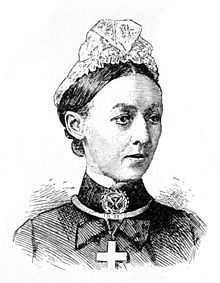Mary Scharlieb

Dame Mary Scharlieb, DBE (1845–1930) was a pioneer British female physician in the late 19th/early 20th centuries.
Biography
Born as Mary Anne Dacomb Bird, she was raised with her grandparents, following her mother's death, in a strict Evangelical Christian household. She attended a boarding school in Manchester, then to one in New Brighton, and finally at the Mrs. Tyndall's School at #16 Upper Hamilton Terrace in London.
Aged 19, she met William Scharlieb, “who was engaged in eating his dinners at the Middle Temple, preparatory to his call to the Bar and subsequent practice in Madras as a barrister”. His initial marriage proposal in February 1865 was met with prompt parental opposition. Mary persisted and eventually the marriage took place in December 1865, and the couple sailed for India almost at once. She became instead one of the first four women students at the Madras Medical College.
In three years she gained her Licentiate in Medicine. She set sail to return to England with her children, old enough by then to travel, in a small ship, her eyes fixed on a degree in medicine. Upon her return to England in 1878 she called on Dr. (Mrs.) Elizabeth Garrett Anderson, the only qualified medical woman until 1877, who had recently started the London School of Medicine for Women. Here she met with small encouragement, her prolonged stay in India and her naturally frail physique producing an unfavourable impression of her ability to follow such a strenuous profession. She was, however, accepted, and in 1879, in company with three other candidates for the first medical examination; she passed.
In November 1882, aged 37, she received a degree of Bachelor of Medicine and Surgery with Honours in all subjects, the Gold Medal and the Scholarship in Obstetrics; shortly after this she gained second-class Honours in Surgery. As did many men at that time, she went for six weeks to study operative midwifery in Vienna, and by her persistence she obtained practice and experience.
She met with Queen Victoria who was curious about the status of Indian women and intrigued by Mary Scharlieb's narrative. Several years later Prof. and Mrs. Scharlieb returned to India, her children being left in London in safe-keeping, Mary Scharlieb returned to India with her husband, Prof. Scharlieb. She was anxious “to find out how far my efforts and sacrifices were likely to be of use to the women in India, both European and native”.
In 1883 she returned to India, and became lecturer in midwifery and gynæcology at the Madras Medical College and examiner in the same subjects to the university of Madras. In 1888 she took her London degree of M.D., and from 1887 to 1902 was surgeon at the New Hospital for Women (now the Elizabeth Garrett Anderson Hospital, Euston Road) initially assisting Dr. Mrs. Anderson, and being senior surgeon from 1889. In 1887 she was appointed lecturer on forensic medicine to the Royal Free Hospital, in 1889 lecturer on midwifery, and in 1902 chief gynæcologist. She retired from these posts in 1909.[1]
She began her private practice after returning again to England, on 21 May 1887, with five patients in the morning, at #75 Park Street, where she was shared an office with her medical student son. Five months later they moved to #149 Harley Street, where she lived and practised for nearly forty years.[citation needed]
In 1897 she obtained the Master of Surgery degree. After she retired from her posts in 1909, she continued in her private professional work. Her new “leisure” time was devoted to public works and to speaking and writing.[citation needed] In 1917 she was made D.B.E. She was a member of the royal commission on Venereal Diseases 1913–16.[1] In 1928 she received honorary LLD from Edinburgh University.
World War I
After the outbreak of World War I she was offered (in September 1914) the charge of one of the Women's Hospitals in Belgium, but, realizing her age and her probable inability to stand the life, she declined. She offered to treat all officers' wives and Belgian women free of charge. She became Chairman of the Midwifery Committee of the Council of War Relief, and spent much of her time and remaining energies in its Maternity Hospital.
Religious beliefs
An extremely devout Anglo-Catholic (Anglican), she opposed contraception and divorce. She stated that “artificial contraceptives are wrong, morally, medically, rationally”. She put in a powerful plea for the exercise of natural means of spacing the family. She spoke of divorce and her belief that it is unjust even to the guilty party, who, if a second union is contracted by the innocent partner, is “thereby prevented from making reparation and by this debarred from full repentance”.
She pled for the Church of England to strengthen and expand its own school system:Among the queerest heresies is that which teaches that children ought not to be biassed, or, as they say, 'prejudiced' in their spiritual outlook ... [S]uch parents and guardians are, indeed, biassing and prejudicing their children's choice, because it is inevitable that children left without religious instruction must grow up in the belief that the truths of religion and the practice of religion cannot be of much importance to their parents.
Writings
- A Woman's Words to Women (1905)
- The Mother's Guide (1905)
- The Seven Ages of Woman (1915)
- The Hope of the Future (1916)
- The Welfare of the Expectant Mother (1919).
Dr Scharlieb wrote an autobiography, Reminiscences, late in life.[citation needed]
External links
- Works by Mary Scharlieb at Project Gutenberg
- Biography at Project Canterbury
- Dame Mary Scharlieb OBE, 1845–1930 at IngentaConnect
- Patient records of the Royal Free Hospital at GENESIS
- Scharlieb, Dame Mary Ann Dacomb (1845–1930) at the National Archives (UK)
References
- ↑ 1.0 1.1
 Chisholm, Hugh, ed. (1922). "Scharlieb, Mary Dacomb". Encyclopædia Britannica (12th ed.). London & New York.
Chisholm, Hugh, ed. (1922). "Scharlieb, Mary Dacomb". Encyclopædia Britannica (12th ed.). London & New York.
|